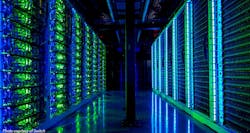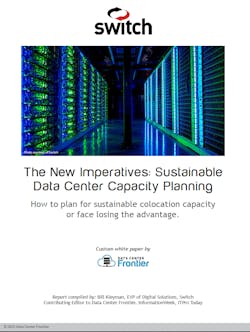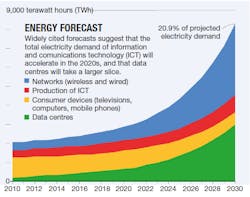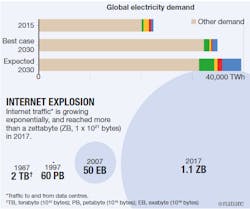Power, Efficiency, and Sustainability: The Data Center is Evolving. Are You?
Data center availability and vacancy rates are at industry-low levels. Beyond just finding space, leaders in the data center and enterprise space are focusing more on resiliency, uptime, and even environmental impacts regarding critical data center systems. The new imperative is this: How can your organization plan for density, capacity, and sustainability while gaining a market advantage? And how can you ensure a faster time-to-market with your digital infrastructure partners?
The answer may revolve around new sustainable data center decision points and a capacity planning checklist.
As emerging trends around sustainability, building greener, and even sustainable debt take hold in this industry, how prepared are you to work with the right partner to support real, sustainable solutions?
This special report article series will explore how sustainability has become a key platform for leaders in the digital infrastructure space. We’ll also dive into the new imperative for technology and business leaders and explore how a capacity and sustainability checklist can get you moving in the right direction.
Introduction
Today’s data center industry is experiencing an unprecedented level of change. Speed-to-market, sustainability, and density are all critical concerns for leaders trying to become a more significant part of the digital infrastructure industry. Bringing capacity online is more challenging than ever before. Coupled with initiatives around sustainable architecture, data center leaders face a new imperative to rethink how they approach critical infrastructure.
Growing demand, shortages of vacancy, and new requirements around sustainability are all impacting how business and technology leaders go to market and stay ahead.
Let’s examine this imperative a bit more. Lead times for equipment have grown substantially. For example, getting a new chiller used to take 16-18 weeks, and now, according to JLL, that wait is 70 weeks or more. The same is held true for generators and enclosures. Where the wait used to be 24-30 weeks, now it’s 50 weeks or more. However, getting parts isn’t the only major challenge. The state of our data center market has fundamentally changed over the past two years. Growing demand, shortages of vacancy, and new requirements around sustainability are all impacting how business and technology leaders go to market and stay ahead. Before we dive more into this new imperative in our market, let’s take a quick look at what’s happening in the data center market.
The State of the Data Center Market
▶ DataCenterHawk: The 463 MW of 2Q 2022 demand in the North American data center region marks another strong period of growth. As a result, the North American primary market vacancy is now averaging 4.4%, its lowest point ever. In Northern Virginia, that vacancy rate is closer to 1%, and this is the first time the average dropped below 5%. The high demand and low vacancy rate are a good representation of where the overall market in the U.S. and Canada sit today. While a few markets with decent capacity are available to meet the demand, most are supply constrained, with data center operators looking at ways to grow quickly.
▶ JLL: The increased demand for data centers continues to pose challenges for the availability of land and power, causing operators to look to new markets with more availability. U.S. market absorption reached 1,087 MW in the first half of 2022, more than 95% of total demand in 2021.
▶ CBRE: Despite a 20% increase in wholesale colocation supply over the past year, developers can barely keep up with demand. Among primary markets, almost 75% of the 1,456.9 megawatts (M.W.) of under-construction capacity in H1 is already preleased. In tandem with increased demand, the amount of new supply currently under construction nearly tripled year-over-year in H1.
So, here’s the big question:
Will your existing architecture support capacity and density and still call itself a sustainable digital infrastructure? Can you keep up with the new imperatives of a constantly evolving digital market?
Let’s explore power, sustainability, capacity, and the new imperatives facing technology and business leaders.
Across the board, data center and business leaders are working with greater density levels, doing more with less, and being asked to deliver advanced solutions as sustainably as possible. Still, power consumption continues to grow. A recent U.S. Department of Energy report indicated that U.S. data centers used about 73 billion kWh in 2020. According to their tracking, this number has been steadily growing since 2000.
So, how do you keep up with the pace of demand? Most of all, how do you ensure that you can effectively deliver data center solutions truly sustainably?
According to Huawei, the global estimate of data center demand is expected to increase by 3 to 10 times by 2030. As the report indicates, green data centers provide effective and eco-friendly solutions in terms of data storage and reduction in energy consumption. The report suggests that these designs are expected to witness great demand, owing to the positive outlook of the data center storage needs and new constructions, which has been brought about due to the regulations and the anticipated rise in need to reduce the operational expenditure.
Let’s explore how emerging sustainability efforts impact digital infrastructure, how leading partners deliver sustainable solutions for some of the world’s most extensive data center requirements, and how a capacity and sustainability checklist can help you with new digital infrastructure imperatives.
Power, Efficiency, and Sustainability Trends
To support emerging digital requirements, we’re seeing that organizations are increasing their spending around critical data centers and cloud systems.
The global data center market size has witnessed a significant boost since the outbreak of the COVID-19 pandemic across the globe. The demand for data centers has increased because of the increased access to internet-related services aided by nationwide lockdowns imposed by governments worldwide.
Organizations face a new challenge with this significant shift around data center resources and applications.
This is where we dive into the first business and technology imperative: How do you sustainably support all these new requirements?
The Power Paradigm Shift
As more organizations expand their data center environments, energy efficiency, capacity planning, and infrastructure management are more closely linked. Not only are data center administrators working hard to cut costs — they’re also working to minimize management overhead and improve infrastructure efficiency and sustainability.
What does this mean for you? In a recent survey by 451 Research, almost a third of multi-tenant data center (MTDC) representatives said all their customers wanted contractually binding commitments to efficiency and sustainability. Another 44% said this was true for most of their customers. Companies with sustainability commitments can no longer afford to use MTDC providers that don’t prioritize carbon-free, sustainable solutions.
Putting Power into Focus
A recent study published in Science concluded that data centers accounted for about 205 terawatt-hours of electricity usage in 2018. According to the report, the 205 terawatt-hours showed a 6% increase in total power consumption since 2010. However, over that same period, data center compute instances across the globe rose by 550%!
When taking this all in, it’s important to note that not all power is consumed equally. And not all capacity is created the same. When you don’t adapt to new digital infrastructure imperatives, the designs of some data centers may result in poor sustainability metrics and the wasting of resources. This is especially true with legacy enterprise data centers. With this in mind, let’s dive into our next topic and explore the second imperative critical to your success.
Download the entire special report, The New Imperatives: Sustainable Data Center Capacity Planning, featuring Switch. to learn more. In our next article, we'll look at legacy data centers.
About the Author






